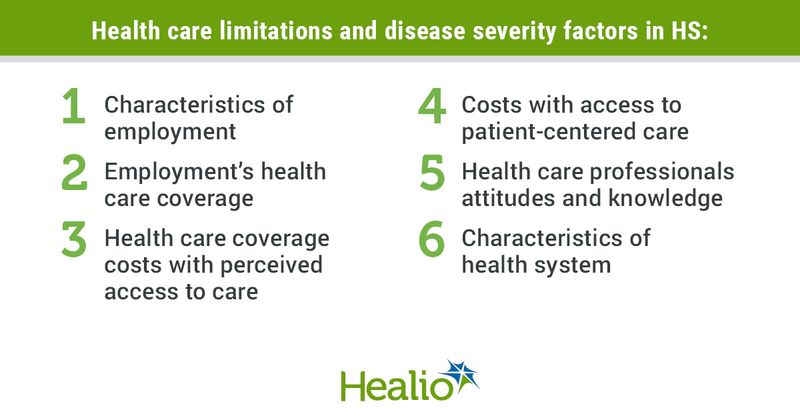Practitioner knowledge, attitude important to patients with hidradenitis suppurativa
Key takeaways:
- Patients shared six common themes as barriers to proper health care for hidradenitis suppurativa.
- Important steps for practitioners to take include improving disease knowledge and in-office attitudes.
Patients with hidradenitis suppurativa expressed six emergent themes that impact their access to proper health care, according to a study.
“People with [hidradenitis suppurativa (HS)] face considerable challenges to health care access, with the average patient experiencing a diagnostic delay of 7 to 10 years,” Leandra A. Barnes, MD, of the department of dermatology at Stanford Medicine, and colleagues wrote. “Additionally, poor understanding of HS biology has limited the development of effective treatments, thereby contributing to substantial quality-of-life impairment.”

In this qualitative study, Barnes and colleagues identified the health care barriers among this disease population as well as possible facilitators to health care access.
The study included 45 patients (49% white; 73% female; mean age 37 years) with HS aged 18 years and older who participated in semi-structured interviews, each conducted over the span of 60 to 90 minutes.
Six health care barrier themes emerged from these results, with the first being bidirectional associations between the patient’s disease activity and their employment. Patients reported missing work or school due to pain, discharge and odor from HS, as well as the need to attend regular doctors’ appointments. Many also reported that their disease dictated their career choices, with patients avoiding jobs that entailed long-term sitting, frequent walking or in-person attendance. Some even reported the need to file for disability due to the debilitating effects of HS.
The second emergent theme was an association between employment and health care coverage, with patients reporting that they would seek out and stay in certain jobs for access to certain types of health insurance coverage and particular providers.
In the third theme, patients detailed the association of health care coverage with costs and perceived access to care. Prohibitive insurance-related costs included co-payments and deductibles, with one patient expressing the need to choose between paying for groceries or going to the doctor.
The fourth theme that provided a barrier to proper care included the time-burden associated with coordinating care and the financial-burden of appointments, medications, travel and supplies.
For the fifth theme, patients reported that the attitude and knowledge of their health care provider influenced their perceived access to care. Results showed that the most important characteristics of health care providers are nonverbal cues for comfort, shame and stigma mitigation, empathy, care, respect, clear communication and an in-depth understanding of HS.
Lastly, characteristics of the health care systems emerged as a barrier to proper care as the sixth reported theme, including the lack of ability to select or change health care providers, scarcity of appointment availability, limited geographic distribution of specialists and lack of a multidisciplinary approach. Patients also expressed a need for cohesive triage care in the home vs. at appointments for flares as well as a need for clear communication among team members involved in treatment.
The need for health care providers and practitioners to familiarize themselves with these six themes is of utmost importance, according to the authors, who stated, “Given the widely recognized historical neglect of people with HS within the medical field and the long-standing lack of approved and effective treatments for this condition, optimizing health care professional attitudes and knowledge about HS are key to providing patient-centered care.”
